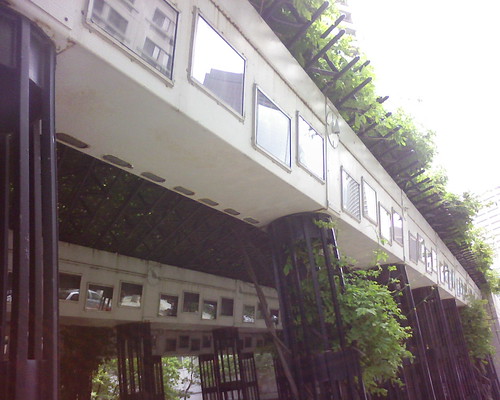
Nam June Paik's Video Arbor @ Franklin Towne Apts.
(location: 17th st. & Spring Garden in Philadelphia just south of Spring Garden)
Biography
Nam June Paik was a Korean-American Contemporary Video Artist of the early twentieth century. Born on July 20, 1932, in Seoul, to a textile entrepreneur father, Nam June started his musical training as a classical pianist right from an early age. He however had to cut it short due to the family's migration to Japan via Hong Kong in 1950 during the Korean War (1950-53).
Nam June Paik graduated from the University of Tokyo in 1956, where he wrote his first thesis on an Austrian-American composer Arnold Schoenberg (1874-1951). Then he moved to Germany where he studied the history of music at the Munich University. Here he also met composers John Cage (1912-92), Wolf Vostell (1932-98), and Karlheinz Stockhausen (1928-2007) who evoked Paik's interest in Electronic Arts. Inspired by John Cage and his technique of using day-to-day sounds in music, Nam participated in Fluxus, a Neo-Dadaist art style. He debuted at the 'Exposition of Music-Electronic Television,' an exhibition where he used distorted images on television sets. Paik was considered the first artist to incorporate Audiovisual Art, merging video and audio records into a single piece.
Paik moved to New York in 1964 and collaborated with American cellist & performance artist Charlotte Moorman (1933-91) to combine his electronic visual presentation with her music & performance. In the work 'TV Cello,' they used stacked television sets to form a cello model, which showed an image of her playing cello as she drew the bow across the screen. Paik and Moorman worked together on 'Opera Sextronique' (1967) and 'TV Bra for Living Sculpture' (1969). Nam June Paik is considered the father of the term 'Information Superhighway,' which refers to digital communication systems and the internet telecommunications network. In 1974, he even innovated the concept of 'Electronic Superhighway' in his transcript called 'Media Planning for the Postindustrial Society.' The same year, an American media technologist Judson Rosebush (b. 1947) compiled Paik's early works in a book titled 'Nam June Paik: Videa 'n' Videology 1959-1973,' published by the Everson Museum of Art, Syracuse, New York.
Nam June Paik's famous works include 'Something Pacific' (1986) with the faces of sitting Buddha on a closed circuit TV. 'Positive Egg' had a video of white egg displayed on the monitor. He used the images of fish in aquarium on different screens for his album 'Video Fish' (1975). His splendid piece 'Electronic Superhighway: Continental U.S., Alaska, Hawaii,' (1995) is an exemplary work on cultural criticism. The piece remains displayed in the Lincoln Gallery of the Smithsonian American Art Museum, Washington DC, in which he conveys his message about America's obsession with television and moving frames. Paik also created robots using wires & metals and eventually radio & television parts.
A display of Paik's work was held in 1982 at the Whitney Museum of American Art, New York. Here, he demonstrated a linkage between South Korea, New York, and Paris. In his work 'Bye Bye Kipling' (1986), Paik created a tape with assorted live programs from South Korea, Japan, and USA. In 1988, he created 'The More the Better,' a massive tower of 1003 monitors for the Seoul Olympic Games. He served as a professor at Kunstakademie Düsseldorf, Dusseldorf, during 1979-96. Paik suffered a stroke in 1996 that left him partially paralyzed. In 2001, the International Sculpture Centre honored him with a Lifetime Achievement Award. Nam June Paik died on January 29, 2006, in Florida.

0 comments: